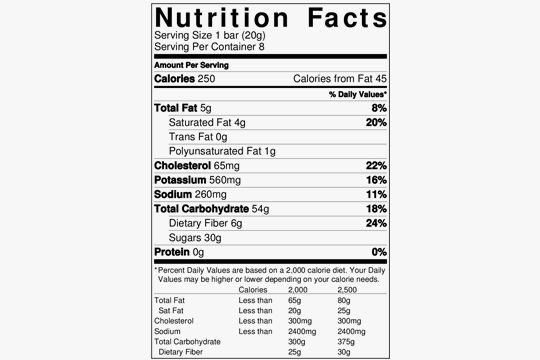
Reducing Food Waste in Foodservice
October 16, 2018 by Doreen Garelick, Dietetic Intern
Our intern Doreen attended a food waste summit for restaurants and compiled these tips to help food service operators redirect…
News Commentary, Nutrition 101
February 28, 2014

What do the proposed changes to the Nutrition Facts Panel actually mean for consumers?
It's been nearly 20 years since the FDA developed the Nutrition Facts Panel required on packaged foods. Recently, the FDA unveiled its proposed makeover of the panel, to reflect developments in nutrition science and eating behaviors.
In the midst of the “low fat” craze of the 80s and 90s, fat was demonized and the nutrition facts label reflected this, letting everyone know how many calories in a product came from fat. Now we understand that while fat is more energy-dense than protein or carbs, the focus should be on the type of fat. Saturated and trans-fats are the unhealthy fats we need to watch out for. While still requiring disclosure of the total amount of fat, saturated fat and trans-fat, the FDA is removing the “Calories from fat” to align with this more recent thinking.
Also encouraging is the FDA's recommendation to distinguish “added sugars” on the label. Sugars occur naturally in foods like fruit and dairy but can also come from sweeteners such as white or brown sugar, honey, and high fructose corn syrup, among others. At SPE Certified, we identify the amount of added sweetener (e.g. sugar, honey, maple syrup, agave) in a certified dish and -- as a dietitian -- I think quantifying added sugars will be very useful for consumers to know more about their food.
Several new vitamins and minerals may also have a place on the label, including potassium and vitamin D. Americans typically consume less than the recommended amount of potassium, so this mineral definitely deserves more attention on the label. However, the list of food sources of vitamin D is short and many foods with vitamin D are fortified. Therefore, I wonder if food manufacturers will focus fortification efforts on these micronutrients, with their increased exposure.
There are other changes, such as a greater emphasis on the number of servings in a package, as well as adjustments to standard serving size to more reasonably reflect how much a person would consume at once. The daily recommendation for sodium is also being slightly reduced to reflect the latest dietary guidance.
No doubt these recommendations will be quite controversial but I believe they are a step in the right direction. Don’t expect to see any changes too soon, though. Following this announcement, the FDA will accept comments from industry, health professionals and the public for 90 days. The recommendations are revised as the FDA considers these comments, of which I’m sure there will be many!
Once a final ruling is made, industry will have time to adjust to the new rule. Nevertheless, this is an exciting opportunity to rehab the nutrition facts label to reflect more recent research and nutrition related health concerns for Americans.
What do you think about the proposed food labeling regulations? Do they go far enough? Let us know your thoughts in the comments below.

October 16, 2018 by Doreen Garelick, Dietetic Intern
Our intern Doreen attended a food waste summit for restaurants and compiled these tips to help food service operators redirect food waste from landfills.
Nutrition 101

Nutrition 101
September 26, 2018 by Doreen Garelick, Dietetic Intern
Ever notice headlines about rapid weightloss? Dietetic Intern Doreen Garelick looks deeper into a recent eye-catching headline to see if there's any truth behind it.
Connect
 Follow us on Twitter
Follow us on Twitter Friend us on Facebook
Friend us on Facebook Follow us on Pinterest
Follow us on Pinterest Follow us on Instagram
Follow us on Instagram Read our Blog
Read our Blog Watch videos on YouTube
Watch videos on YouTube Watch videos on Vimeo
Watch videos on Vimeo Connect with us on Linkedin
Connect with us on Linkedin Find us on Foursquare
Find us on Foursquare
Tweets by @SPEcertifiedBlog Search
Categories
SPE Certified Newsletter
Sign up for news on the latest SPE-certified venues, events and SPE updates.
We will never share your personal information with a third party.